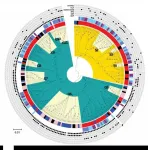(Press-News.org) Carbon dioxide emissions in Los Angeles fell 33% in April of 2020 compared with previous years, as roads emptied and economic activity slowed due to the COVID-19 pandemic, according to a new study in Geophysical Research Letters. In the Washington, D.C./Baltimore region, emissions of carbon dioxide, or CO2, dropped by 34% during the same period.
The study was led by scientists at NASA's Jet Propulsion Laboratory (JPL), the National Institute of Standards and Technology (NIST) and the University of Notre Dame.
While the emissions reductions are significant, the method that scientists used to measure them may have the greater long-term impact.
In both locations, scientists had previously installed networks of sensors on rooftops and towers to monitor the concentration of CO2 in the air. They used the data from those sensor networks to estimate the drop in emissions.
This might seem an obvious way to estimate emissions, but this is not how it's usually done. Most cities estimate their emissions by tallying up the effects of activities that cause emissions, such as the number of vehicle miles traveled or the square footage of buildings heated and cooled. These are called "bottom up" methods because they are mostly based on activities on the ground.
This new study demonstrates that "top-down" methods, based on measuring the concentration of CO2 in the air, can produce reliable emissions estimates. Scientists were able to test those methods when emissions suddenly dropped due to COVID-19.
"This was a completely unanticipated experiment, and one we don't ever want to do again," said lead author and JPL data scientist Vineet Yadav. "But our results show that we were able to detect the onset of emissions reductions to within a few days."
Scientists have been developing top-down methods for measuring CO2 emissions for several years. "This study shows that the technology has matured enough to produce reliable results and can be put into operation," said NIST scientist and co-author Kimberly Mueller. That would give cities an important new tool in their efforts to reduce emissions.
Top-down estimates are difficult to achieve because most of the CO2 in the air above cities is not from local emissions. Most of it is there naturally, and some is emitted outside the city's borders and comes in on the wind. The trick is to figure out how much of the CO2 in the air above the city was generated locally.
"My Ph.D. adviser used to describe the atmosphere as a big cup of coffee," said Mueller. "You've added cream, and you're trying to unstir the coffee to see where and when you put the cream in."
To unstir the atmospheric coffee, scientists used data on wind speed, direction and other factors. This allowed them to estimate where within a city the emissions originated and how large they were.
Though difficult to achieve, top-down measurements have several advantages. First, they can provide relatively quick feedback on whether efforts to reduce emissions are working. If a city changes traffic patterns or increases public transit, for instance, top-down estimates can provide data on whether those efforts actually lead to reduced emissions.
In addition, a recent study, also co-authored by Mueller, indicated that U.S. cities often underestimate their emissions when using bottom-up methods alone. Another recent study showed that combining bottom-up with top-down methods increases accuracy. (Both studies were partly funded by NIST.)
"Accurate measurements are key to any strategy for managing greenhouse gas emissions," said James Whetstone, leader of NIST's greenhouse gas measurements group and a co-author of the study. "That's the only way to know if you are making progress toward your goals."
NIST, NASA and other research partners are using the sensor networks in Los Angeles and the Washington, D.C./Baltimore region to develop and test top-down methods as a way of achieving more accurate emissions estimates. This research project focuses on cities in part because cities account for a large and growing share of the world's CO2 emissions.
The 33% and 34% emissions drops in Los Angeles and the D.C./Baltimore region represent reductions relative to the average April emissions of the previous two years. The researchers used three different methods for detecting the change in emissions based on atmospheric measurements, all of which detected the drop occurring at the same time.
"These independent statistical tests on different pieces of the puzzle gave consistent results," said Notre Dame computational scientist and coauthor Subhomoy Ghosh. "This gives us confidence in the findings."
In addition, the methods appeared to work well in both locations, despite very different environmental conditions. In Los Angeles, relatively clean air comes in off the Pacific. D.C. and Baltimore, on the other hand, regularly receive emissions from cities and power plants to the west. Also in D.C. and Baltimore, emissions models have to account for the effects of spring, when plants turn green again and start pulling CO2 from the air. Los Angeles experiences less seasonal variation in uptake by plants.
"These methods were robust enough to work in very different settings," Mueller said. "The fact that these methods worked in both locations mean the results were not a fluke."
INFORMATION:
Paper: V. Yadav, S. Ghosh, K. Mueller, A. Karion, G. Roest, S.M. Gourdji, I. Lopez-Coto, K. R. Gurney, N. Parazoo, K.R. Verhulst, J. Kim, S. Prinzivalli, C. Fain, T. Nehrkorn, M. Mountain, R.F. Keeling, R.F. Weiss, R. Duren, C.E. Miller and J. Whetstone. The impact of COVID-19 on CO2 emissions in the Los Angeles and Washington DC/Baltimore metropolitan areas. Geophysical Research Letters. Published online June 7, 2021. DOI: 10.1029/2021GL092744
Research between the University of Liverpool, UK and National Tsing Hua University (NTHU), Taiwan has revealed a new charge storage mechanism that has the potential to allow rechargeability within calcium-air batteries.
In a paper published in the journal Chemical Science, Professor Laurence Hardwick from the University of Liverpool's Stephenson Institute for Renewable Energy (SIRE) and colleagues discover a distinctive form of charge storage at the electrode interface described as trapped interfacial redox. This new finding introduces a new mechanism of charge storage that could be harnessed in practical devices.
Lead author of the paper, Yi Ting (Leo) Lu, is a joint PhD student in ...
A new study at the University of Chicago has determined that restoring a single microbial species -- Bacteroides sp. CL1-UC (Bc) -- to the gut microbiome at a key developmental timepoint can prevent antibiotic-induced colitis in a mouse model of the condition. The results, published on June 7 in END ...
TROY, N.Y. -- More strategic and coordinated travel restrictions likely could have reduced the spread of COVID-19 in the early stages of the pandemic. That's according to new research published in Communications Physics. This finding stems from new modeling conducted by a multidisciplinary team of scientists and engineers at Rensselaer Polytechnic Institute.
The researchers evaluated the distance between countries in terms of air travel, a more complex measurement than simply mapping physical distance. For instance, while China and Thailand may be geographically more proximate to one another, if there are significantly ...
In young women, Staphylococcus saprophyticus is a main cause of urinary tract infections (UTI), reaching 20% prevalence. Understanding the epidemiology of this microorganism can help identify its origin, distribution, causes, and risk factors. Now, ITQB NOVA researchers led by Maria Miragaia showed evidence that Staphylococcus saprophyticus can originate in food, namely in the meat-production chain.
Europe is the world's second-biggest producer of pork, the most favored meat type in these countries. One of the contaminants of that meat is S. saprophyticus, which is found also in the environment, ...
BOSTON - Current guidelines recommend stopping cervical cancer screening at age 65, but women over age 65 make up over one in five new cervical cancer diagnoses, and are twice as likely to die after a cervical cancer diagnosis compared to younger women. New research from Boston Medical Center found that fewer than one in three women aged 64 to 66 met the criteria to discontinue cervical cancer screening while looking at patients with both private insurance and from a safety-net hospital setting. Published in Gynecologic Oncology, researchers found that even among women with 10 years of continuous insurance coverage, ...
GAINESVILLE, Fla. --- A more reliable way of estimating the size of megalodon shows the extinct shark may have been bigger than previously thought, measuring up to 65 feet, nearly the length of two school buses. Earlier studies had ball-parked the massive predator at about 50 to 60 feet long.
The revised estimate is the result of new equations based on the width of megalodon's teeth - and began with a high school lesson that went awry.
Victor Perez, then a doctoral student at the Florida Museum of Natural History, was guiding students through a math ...
PHILADELPHIA (June 7, 2021) - An article written almost 30 years ago helps frame social constructs around the COVID-19 pandemic. By reviewing the essay, an historian of nursing at the University of Pennsylvania School of Nursing (Penn Nursing) extends that construct to include nurses and patients, delivering a local and personal meaning to the epidemic experience.
In an essay in the Bulletin of the History of Medicine, Julie A. Fairman, PhD, RN, FAAN, Endowed Chair, the Nightingale Professor in Honor of Nursing Veterans, and Professor of Nursing at Penn Nursing, reviews Charles Rosenberg's 1992 article about the AIDS epidemic. Using Rosenberg's theme, she further develops the ...
Metal halide perovskites have been under intense investigation over the last decade due to the remarkable rise in their performance in optoelectronic devices such as solar cells or light-emitting diodes. Despite tremendous progress in this field, many fundamental aspects of the photophysics of perovskite materials remain unknown, such as a detailed understanding of their defect physics and charge recombination mechanisms. These are typically studied by measuring the photoluminescence - i.e. the emission of light upon photoexcitation - of the material in both the steady-state and transient regimes. ...
Rockville, Md. (June 7, 2021) - Healthy habits are particularly important during pregnancy. Four new studies being presented at NUTRITION 2021 LIVE ONLINE look at how supplements, eating habits and physical activity can affect various aspects of health during pregnancy.
Prenatal supplements might influence bacterial composition of breast milk
Breast milk contains a unique mix of bacteria - known as its microbiota - that plays an important role in child health. In a new study, researchers from Purdue University examined whether diet or supplements taken prenatally affected the microbiota of breast milk in 771 mothers participating in the CHILD Cohort Study. The analysis revealed that supplements, but not dietary patterns, were linked with changes in human milk microbiota ...
Rockville, Maryland (June 7, 2021) -- Only 5% of men and 9% of women are getting the recommended daily amount of dietary fiber, according to a study being presented at NUTRITION 2021 LIVE ONLINE. Insufficient fiber intake is associated with a higher risk of heart disease and diabetes, two of the most common diseases in the U.S.
"These findings should remind people to choose fiber-rich foods like whole grains, fruits and vegetables to reduce their risk for heart disease," said Derek Miketinas, PhD, RD, an assistant professor at Texas Woman's University, the study's ...






